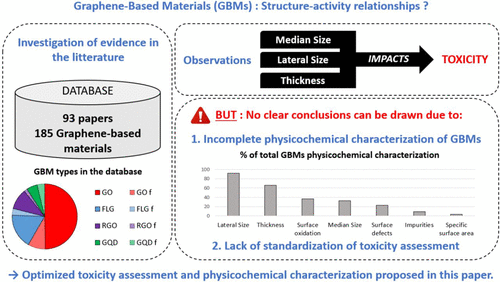当前位置:
X-MOL 学术
›
Chem. Res. Toxicol.
›
论文详情
Our official English website, www.x-mol.net, welcomes your
feedback! (Note: you will need to create a separate account there.)
Graphene-Based Materials In Vitro Toxicity and Their Structure–Activity Relationships: A Systematic Literature Review
Chemical Research in Toxicology ( IF 3.7 ) Pub Date : 2021-08-23 , DOI: 10.1021/acs.chemrestox.1c00243 Salma Achawi 1, 2 , Jérémie Pourchez 2 , Bruno Feneon 1 , Valérie Forest 2
Chemical Research in Toxicology ( IF 3.7 ) Pub Date : 2021-08-23 , DOI: 10.1021/acs.chemrestox.1c00243 Salma Achawi 1, 2 , Jérémie Pourchez 2 , Bruno Feneon 1 , Valérie Forest 2
Affiliation

|
The unique properties of graphene-based materials (GBMs) placed them among the most exciting nanomaterials of the past decade. Scientists and industry are looking forward to working with not only efficient but also safe, sustainable GBMs. Designing a safer-by-design GBM implies to acquire the knowledge of which physicochemical characteristics (PCCs) can increase toxicity. In this systematic review, we extracted data from the literature to provide the available information about the structure–activity relationship of GBMs. 93 papers studying a total of 185 GBMs are included. Graphene oxides (GOs) and few-layer graphenes (FLGs) are the most studied GBMs. While reduced graphene oxides were often classified as poorly oxidant and weakly cytotoxic, graphene quantum dots were mostly moderately or highly cytotoxic. FLGs demonstrated relationships between median size and oxidative stress, between lateral size and both cytotoxicity and oxidative stress, and between thickness and cytotoxicity. We also underline relationships between median size, lateral size, and thickness of GOs and oxidative stress. However, it appears difficult to highlight clear structure–activity relationships for most PCCs and biological end points because despite a large amount of available data, the GBMs are often too poorly characterized in terms of PCCs descriptors and the biological end points investigation is not standardized enough. There is an urgent need for a better standardization of the experimental investigation of both PCCs and biological end points to allow research teams to play a part in the collaborative work toward the construction of a safer-by-design GBM through a better understanding of their key toxicity drivers.
中文翻译:

石墨烯基材料的体外毒性及其结构-活性关系:系统文献综述
石墨烯基材料 (GBM) 的独特性能使其成为过去十年中最令人兴奋的纳米材料之一。科学家和工业界期待与不仅高效而且安全、可持续的 GBM 合作。设计更安全的 GBM 意味着了解哪些理化特性 (PCC) 会增加毒性。在本系统评价中,我们从文献中提取数据以提供有关 GBM 构效关系的可用信息。包括 93 篇论文,共研究了 185 个 GBM。氧化石墨烯 (GO) 和少层石墨烯 (FLG) 是研究最多的 GBM。虽然还原氧化石墨烯通常被归类为弱氧化剂和弱细胞毒性,但石墨烯量子点大多具有中等或高度细胞毒性。FLG 证明了中值尺寸与氧化应激之间、横向尺寸与细胞毒性和氧化应激之间以及厚度与细胞毒性之间的关系。我们还强调了 GO 的中值尺寸、横向尺寸和厚度与氧化应激之间的关系。然而,似乎很难强调大多数 PCC 和生物终点的清晰结构-活性关系,因为尽管有大量可用数据,但 GBM 在 PCC 描述符方面的特征往往太差,而且生物终点调查不够标准化.
更新日期:2021-09-20
中文翻译:

石墨烯基材料的体外毒性及其结构-活性关系:系统文献综述
石墨烯基材料 (GBM) 的独特性能使其成为过去十年中最令人兴奋的纳米材料之一。科学家和工业界期待与不仅高效而且安全、可持续的 GBM 合作。设计更安全的 GBM 意味着了解哪些理化特性 (PCC) 会增加毒性。在本系统评价中,我们从文献中提取数据以提供有关 GBM 构效关系的可用信息。包括 93 篇论文,共研究了 185 个 GBM。氧化石墨烯 (GO) 和少层石墨烯 (FLG) 是研究最多的 GBM。虽然还原氧化石墨烯通常被归类为弱氧化剂和弱细胞毒性,但石墨烯量子点大多具有中等或高度细胞毒性。FLG 证明了中值尺寸与氧化应激之间、横向尺寸与细胞毒性和氧化应激之间以及厚度与细胞毒性之间的关系。我们还强调了 GO 的中值尺寸、横向尺寸和厚度与氧化应激之间的关系。然而,似乎很难强调大多数 PCC 和生物终点的清晰结构-活性关系,因为尽管有大量可用数据,但 GBM 在 PCC 描述符方面的特征往往太差,而且生物终点调查不够标准化.











































 京公网安备 11010802027423号
京公网安备 11010802027423号